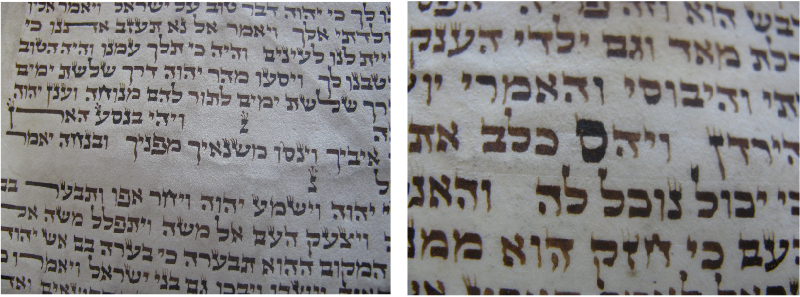- Home
- Activities
- Letters
- Diary
- Tools
- Books
- Education
- Sources
- Oddities
-
MORE
- About me
- Sefer Torah
- Tefillin
- Pittum HaKtoret
- Ketubah
- Alefbet
- Diary 1
- Diary 2
- Diary 3
- Diary 3a
- Diary 4
- Diary 5
- Diary 6
- Diary 7
- Diary 8
- Repairs
- More Repairs
- Yet More Repairs
- Diary 45
- Diary 39
- Broken Vav
- Joined Kuf
- Diary 11
- Diary 46
- Diary 47
- Siyyum
- Some siyyumim
- Diary 26
- Diary 27
- Raised vav
- Kulmus
- Giddin
- Purim shpiels
- Diary 40
- Diary 42
- Kulmus Books
- Mezuzah
- Large letters
- Diary 48
- Diary 49
- Diary 18
- Sefer Binsoa
- Dyo
- Klaf
- In the End
- Adventures in Practical Halachah
- Sefer Tagin Fragments from the Cairo Genizah
- Diary 50
- Megillat Esther
- My first megillah
- 2018 Megillah
- The E-Fuzzy
- Ketubah 2 Avielah's Gallery
- Publications and audio visual
- Old Harrys Ketubah
- Commemorative illuminations
- Diary 51
- Diary 52
Diary 42

Diary 42- Space - the final frontier
Well actually no, this diary isn’t about Star Trek. It isn’t even about the Hitch-Hikers Guide to the Galaxy - though it is diary number 42 and by a staggering coincidence (by the way there is no such thing as a coincidence) the answer to life the universe and everything is exactly the same number as the lines in a standard tikkun
for a Sefer Torah. Amazing.
Instead this diary is about spaces - the absence of letters. And in particular it is about a tradition that has died out regarding spacing between p’sukim
(verses). Measurements for the Torah are very proscribed. There is a space of two fingers between the amudim
(columns) and there is a space of of at least three fingers for the top margin and four fingers for the bottom margin. Between each line there is the space of a line. Between each word there is a the space of a small letter (at least a yud
but usually more) and between each letters the space of a hair. Between each section there is a space of 9 letters either s’tumah
(closed) or p’tucha
(open) - a complex area as Rambam and Rosh don’t agree what this is. Before the start of each book of the Torah
(excepting B’reshit) one leaves the space of four lines and before each book of Prophets (if you join them) three lines.
And ... according to the Machzor Vitri
and the Yemenite community (and others) a space of a word between each pasuk
(sentence). Except that there isn’t! And that isn't our custom at all. In fact there are many who would pasul
such a Torah.
Well this custom certainly was there in the past, except that the space left is closer to two letter spaces. And this idea is jolly clever as one of the hardest things in leining Torah is not knowing the end of the pasuk. This is particularly difficult if in between the p’sukim one is supposed to read the Targum (Aramaic translation) as one is supposed to and as one does in the Yemenite shuls even today. Hence the idea of a gap between sentences is a jolly good one and probably why this became a tradition with the Teymanim. So why isn’t it generally done. Well one reason might be that the verse divisions are largely a Christian invention which Jews adopted (that said the t'amim (notes) do kind if give verse breaks anyway). One other reason might be that having the sentences break like that may prevent midrash that comes from joining verses together. Who knows.
Well this custom certainly was there in the past, except that the space left is closer to two letter spaces. And this idea is jolly clever as one of the hardest things in leining Torah is not knowing the end of the pasuk. This is particularly difficult if in between the p’sukim one is supposed to read the Targum (Aramaic translation) as one is supposed to and as one does in the Yemenite shuls even today. Hence the idea of a gap between sentences is a jolly good one and probably why this became a tradition with the Teymanim. So why isn’t it generally done. Well one reason might be that the verse divisions are largely a Christian invention which Jews adopted (that said the t'amim (notes) do kind if give verse breaks anyway). One other reason might be that having the sentences break like that may prevent midrash that comes from joining verses together. Who knows.
I only ask because I checked an Ashkenazi Torah
and surprisingly, as well as having all the large letters (not just the accepted ones) it also had extra spaces for the verse divisions. Also, in my researches on Megillat Esther
I came across a photo of old Megillah
that also had these breaks between p’sukim. Also reading one of my sofrut
book acquisitions STa"M K’hilchatan, I came across a debate about the validity of these spaces and finally, in I opened a copy of the Machzor Vitri
to see how he laid out his m'zuzah
and it has very pronounced spaces between sentences. Coincidence - I don’t think so. Spaces between sentences is clearly something about which I was being prompted to find out more about.
Below: two examples from the
Ashkenazi Torah showing larger gaps between p’sukim. Look at the spaces between
v’Hevel and
ha-lo. Photo © Mordechai Pinchas.
Below left: The
nun hafuchot section from the same
Torah - but look at the space between mipanecha and
u’v’nucho. Below right: Similarly the space before
v’yahas (which only sometimes has a large
samech). Photos © Mordechai Pinchas.
Below left and centre: two sections from an old manuscript of
Megillat Esther which also shows the same enlarged spaces between verses. Below: Machzor Vitri Sh’ma - note the huge spaces between
p’sukim.
Why has the tradition been abandoned? Given it makes reading so much easier why doesn’t it come back? What do people think?
GO TO DIARY 43




